Football
Line Segment: Injuries and Scheme Take Toll Against TCU

Generally after Oklahoma State losses I avoid interaction with anyone for at least 48 hours, but I was able to muster up the strength to watch the film today and break down not only the offensive line, but also some other aspects as well.
The first thing I noticed is that TCU was able to display a lot of talent at many levels and is a team that could definitely make some noise the rest of the season.
The Oklahoma State offensive line struggled for the majority of the game, both to create consistent rush lanes and also to protect the passer. Although I do think the offensive scheme and strategy failed them as well, and might have been a bigger issue than the execution itself.
We knew before the kickoff that OSU would be without RT Zach Crabtree and RG Larry Williams, being replaced by RT Tevin Jenkins and RG Johnny Wilson. That’s your entire right side of the offensive line, and although Tevin Jenkins played a really nice game vs. Pitt, there was still reason to be concerned.
Out of 36 true drop backs, I recorded 24 clean pockets. That means 33 percent of the time Rudolph was facing pressure in some capacity. Not surprisingly most of the pressure all day was coming off of the right side as both Jenkins and Wilson had tough days. TCU definitely capitalized on this, and No. 15 (who is a tremendous player) had a lot of success providing disruption. Officially OSU gave up 3 sacks, but it felt more like 30 while watching the game live.
“(They) have to make plays,” said Mike Gundy after the game. “When we lose guys, the next guy has to come in and make plays.”
Here are some things I highlighted.
• Tevin Jenkins had a tough day. Before I get into him, I wanted to mention that he had a really tough task of moving over to the right side and facing some excellent pass rushers. I think the coaching staff put a lot of pressure on him that could’ve been avoided.
• On this play No. 15 beats Jenkins around the edge for the QB hurry. No. 15 is a really good player, he showed up all over the place.
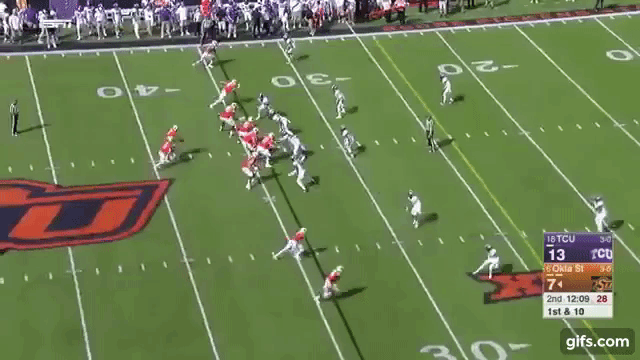
• Here’s Jenkins getting beat inside by No. 9 for the sack. No. 9 also had a nice game.

• This play really confuses me. I don’t know why Jenkins is blocking down and leaving the DE for Britton Abbott. That leaves Abbott in a tough spot, and he ends up getting beat around the edge. Rudolph ends up rolling out and making a huge throw, he’s much improved on improvising on plays like these.
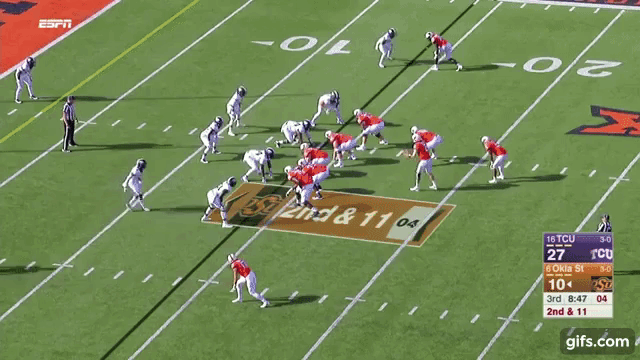
• Same situation here. Jenkins blocks down and leaves DE for Abbott. Since it happened again, it leads me to believe this was designed. This is either a mental mistake or bad scheme, either way it leads to unwanted pressure for Rudolph. If this was designed to isolate a DE with a Cowboy Back then I hope OSU burns this play.
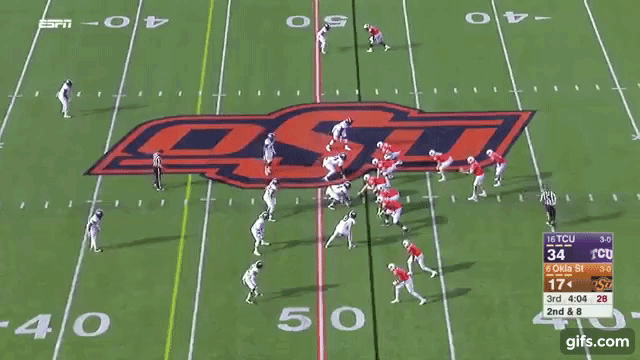
• Johnny Wilson gets beat inside here. Drive killer.

• Wilson gets beat on the next play causing a QB hurry.
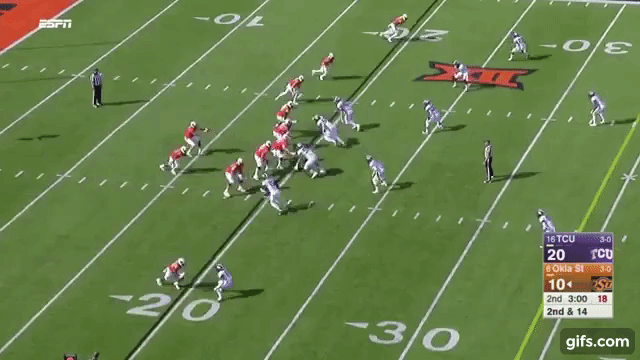
Notice a trend? Yes, Wilson and Jenkins had rough games. I’m pretty sure most people expected there to be growing pains here. Going up against a solid front from TCU, I expected there to be mistakes and missed assignments. The problem is why was the game called like OSU had all five regular starters in the game?
TCU was able to get way too much pressure at times with a three-man rush. Again No. 15 is giving Jenkins a tough time on the right edge. Jenkins gets overextended, and No. 15 has really good hands and quickness.
Rudolph is able to step up and buy time, which is exactly what he needs to do. The rest is 100 percent Rudolph’s fault. Once you feel pressure and break out of the pocket, you have to know you will be facing a secondary rush from pass rushers coming back around.
This is not the RT’s responsibility, he is responsible for creating the pocket, once it breaks down the QB has to have the awareness to feel the rush. There is plenty of green in front of him, pull the ball down and take 5 yards to live another down.
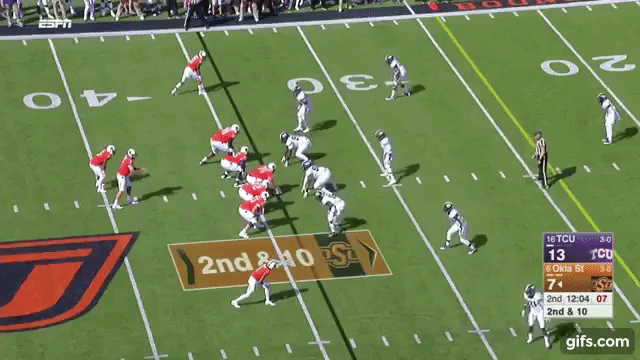
• Rudolph has all day here. This is fantastic coverage paired with a poor check down throw to Hill.
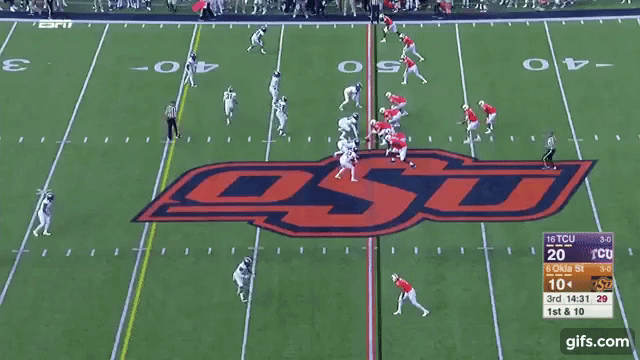
• Solid work here, nice job by Lundblade sealing the second level LB.
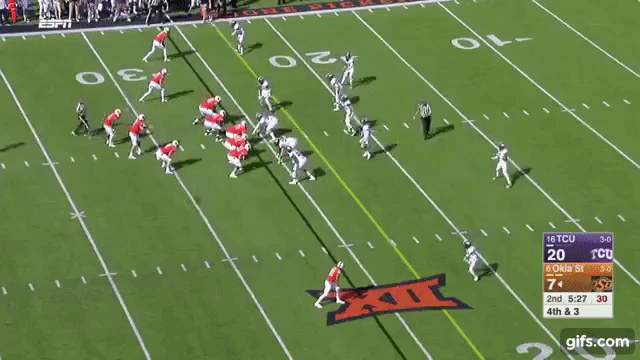
• Rudolph has plenty of time and a very nice pocket. This play is not open and was well accounted for. This is just two football players that are really good.
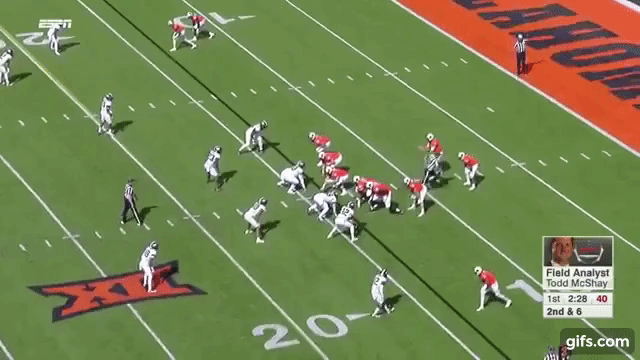
I haven’t highlighted the run blocking as much because there weren’t as many breakdowns in play. The run game was average, but is so crucial to the game plan when facing a Gary Patterson defense.
Other offensive observations:
This was one of Mike Yurcich’s worst games as a play caller in my opinion, and I’m a big fan of his and still am. I don’t think he would disagree, based off some of the post-game comments. Given the fact that you are breaking in new starters on the right side of the offensive line, I felt Yurcich failed to scheme correctly to try to hide that.
TCU was able to provide a ton of pressure off the right side and completely change the flow of the game. I also feel like he failed to call plays that put stress on TCU’s secondary.
Gary Patterson’s 4-2-5 defense is really unique, and a fantastic defensive scheme. It’s unique in the sense that he breaks down his coverage, and sometimes there can be a different call on each side of the field (sometimes called divorcing coverage).
But when you break it down there are still some of the same switch responsibilities that OSU saw vs. Pat Narduzzi and his defensive scheme. Patterson will run Cover 2 and a version of Quarters coverage. The idea to beat that is to build route concepts where you make DB/LBs make quick decisions (and hopefully the wrong ones). Since some of these defenders are passing responsibility onto each other based off of the route run by the WR, the goal is to package routes together to put stress on the scheme.
What I saw was completely the opposite of that. Route combinations that not only were long developing, which isn’t ideal the OL situation, but also independent of each other. Which doesn’t cause any stress on the switch responsibilities.
Here is a good example, and a great camera view as well. You have a max protection look with both Hill and Abbott staying in to block. Washington runs a short stop route, which I assume is a decoy and possible dump down if the corner sinks far up the field enough.
Initial read is Stoner in the slot, he is completely bracketed in addition to the safety on the other side. This safety’s role is most likely the Robber since there wasn’t a vertical route on his side, he is just watching the QB’s eyes and playing center field.
There are no layered routes where you’re making DBs make quick decisions. There is no one open, where is the check down? What about this route combination is hard to defend?
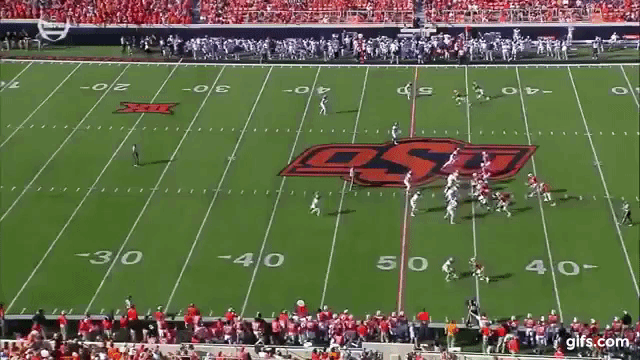
Here is a good example of a great route combination. It took me until the 4th quarter to find something of this caliber. Stoner is in the slot and is bracketed, he runs off both the underneath coverage and the safety over the top.
The underneath out route by McCleskey occupies a DB out wide, and Washington is wide open on a curl 1 on 1 vs. a DB who is dropping back into a deep zone coverage. These are the types of plays needed to a beat Gary Patterson-led defense, especially when you don’t have a run game to rely on like 2016.
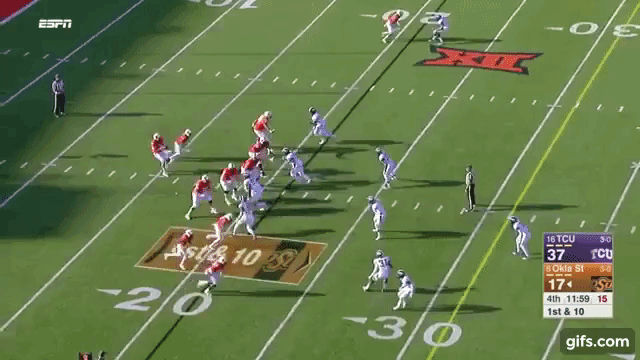
I was also a little frustrated with fact that OSU ran so many vertical routes, and forced the ball to the sidelines. I understand that this team is built on big plays, but TCU came into this game planning to stop the big play and it showed. Pair that with a lackluster run game, and TCU was able to sit back into a deep coverage frequently.
James Washington was able to beat coverage with help over the top on his long TD, but that isn’t something you can consistently rely on. Running plays with layered route combinations will only help the vertical passing game vs. a defense like this.
Here is an example of a RPO with an underneath route that was WIDE OPEN. OSU has made a killing off of this look all year, and for some reason went away from this all game.
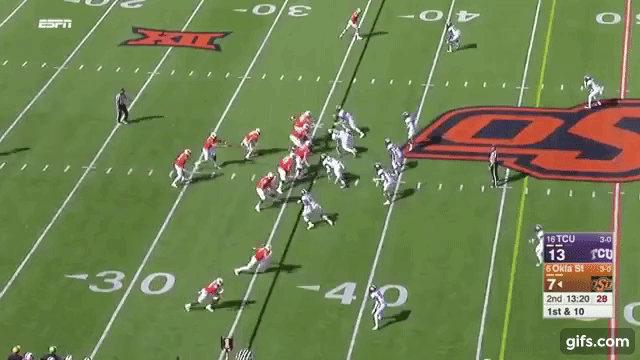
Given the fact that OSU was breaking in two new starters on the OL, I was expecting Yurcich to create a friendly game plan to ease them in. I didn’t see that as he ran a lot of plays with long developing routes and TCU had the coverage to match. I would’ve liked to see more draw plays such as this to help with some really aggressive DEs getting up field from TCU.
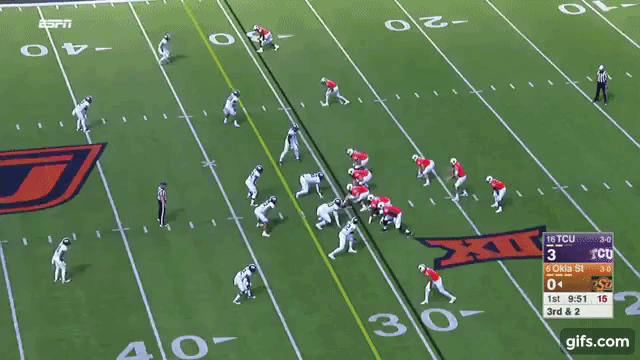
Some final notes. There was space underneath for Stoner and Mckleskey, but Yurcich chose not to exploit that area. It was clear that TCU wasn’t going to allow OSU to beat them deep.
It wasn’t until late in the 4th when OSU was moving the ball well, that I saw the OSU offense work the middle of the field. I also don’t think Yurcich was able to stretch the field east and west, everything was vertical. A big reason why this play didn’t work, why should you fall for a fake when they throw it deep every play?

Also Rudolph is at fault as well based off his playing tendencies. Thomas Fleming mentioned this in the chat we have and I thought it was spot on. Rudolph tends to make reads from deep to intermediate at times, and this is a problem when all of your deep routes are being taken away.
The inability to run the ball or innovate ways to generate production around the line of scrimmage east/west and find a consistent intermediate passing game is ultimately what sunk OSU from an offensive perspective (along with the turnovers).
I have to give it up to TCU, even with the scheme deficiencies, they did an amazing job on defense. Their secondary was lights out and they were able to pressure Rudolph consistently. Also forcing four turnovers was a complete game changer. Hats off to them.
Time to regroup and gear up for Texas Tech.

-

 Daily Bullets5 days ago
Daily Bullets5 days agoDaily Bullets (Apr. 19): Bedlam Gametime Moved, Cowboy Receivers Breed Confidence
-

 Football4 days ago
Football4 days agoFour-Star Wide Receiver Jaden Perez Commits to Oklahoma State
-

 Wrestling4 days ago
Wrestling4 days agoOSU Wrestling: Olympic Chances End for Cowboy Hopefuls
-

 Football1 day ago
Football1 day agoFour-Star Quarterback Adam Schobel Commits to Oklahoma State, Flips from Baylor






